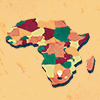It was September 2007 and I was in Monte Carlo for a friend’s wedding.
We prayed that Saturday morning at the local synagogue and later walked to the nearby Hotel de Paris. Entering the lobby, I was surprised at the large security presence. I soon learned that the legendary former South African president Nelson Mandela was a guest in the hotel. As it happened, he was sitting in one of the stately public rooms on the lobby floor as I passed by.
I instinctively wanted to meet the iconic statesman. The slim chance of gaining access to meet Mandela did not stop me from asking the security guard at the door if I could please step in to bless the former president. Just then, a second member of the security detail approached and asked what I wanted. The first bodyguard explained that I was a rabbi who wanted to bless Madiba on the holy Sabbath. They agreed to let me go over to greet him.
As I approached the former president, he looked up and beamed. I was dressed in the full Chabad Shabbat attire, the flowing black frock and black fedora, and since I had just left the synagogue my white and black tallit was draped over my shoulders.
After we had been introduced, Madiba invited me to sit near him. He asked me to please bless him and mentioned how touched he was that I had blessed him on the Sabbath. President Mandela also told me how much he cherished it when ‘his rabbi,’ Chief Rabbi Cyril Harris, would bless him back home.
Looking across at the great man, who had suffered for decades, fought for freedom, and pulled a splintered nation together, I felt compelled to ask one question. Had he ever compared his story to that of the biblical Joseph?
Without pause, Madiba replied that he felt a strong affinity with Joseph. Joseph had been imprisoned for life, yet he found strength in his positive outlook and had finally emerged to lead a nation. With twinkling eyes, Mandela laughed out loud: “But I spent many more years in prison then Joseph did!”
I then asked him, “Is it in honor of Joseph’s coat of many colors that you wear your trademark colorful “Madiba shirts”?
“No,” he replied, “I wear these shirts to represent my people and their struggle and to represent the beautiful diverse cultures and traditions of Africa.” He tenderly touched the African continent embroidered on his custom-made silk black shirt.
We chatted easily and he shared the story behind the Madiba shirts. On the first Shabbat after he had been elected president, back in May 1994, he visited South Africa’s largest synagogue, the Green and Sea Point Hebrew Congregation in Cape Town. “His rabbi,” Chief Rabbi Harris had invited him to attend morning services.
Mandela recounted how he had addressed the packed crowd and had “appealed to the local Jewish community to implore their South African family members who had emigrated to return home to help rebuild a new democratic South Africa.” He also reassured the local Jewish community not to be afraid of a Government of National Unity and promised that “together we will succeed.”
He then recalled, “When I returned to the motorcade, my driver handed me a gift from a women who had attended synagogue that morning. It was a beautiful black shirt, with a colorful design of golden fish across it. I chose to wear that shirt to the opening of parliament of our new democratic government.”
“After I had worn that shirt, this same woman (South African designer Desre Buirski) would continue to send me shirts. We become good friends, and she designed hundreds of shirts for me. These shirts help me carry my message all over the world.”
He smiled and added, “And all because I went to synagogue on a Saturday morning.”
I stood up and thanked him for the generosity of his time and the honor of meeting him. Before I walked off, Mr. Mandela complimented the traditional look of my Chassidic dress. “I am happy to see you dressed this way; you should always be proud to wear the clothing of the Jewish faith as a mark of honor,” he said.
As I shook his hand, he told me, “Remember young rabbi, when you dress in your royal garb, you represent what the Bible stands for: How all humans are G‑d’s children, created in the image of G‑d, regardless of ethnicity, color or faith.”







Join the Discussion